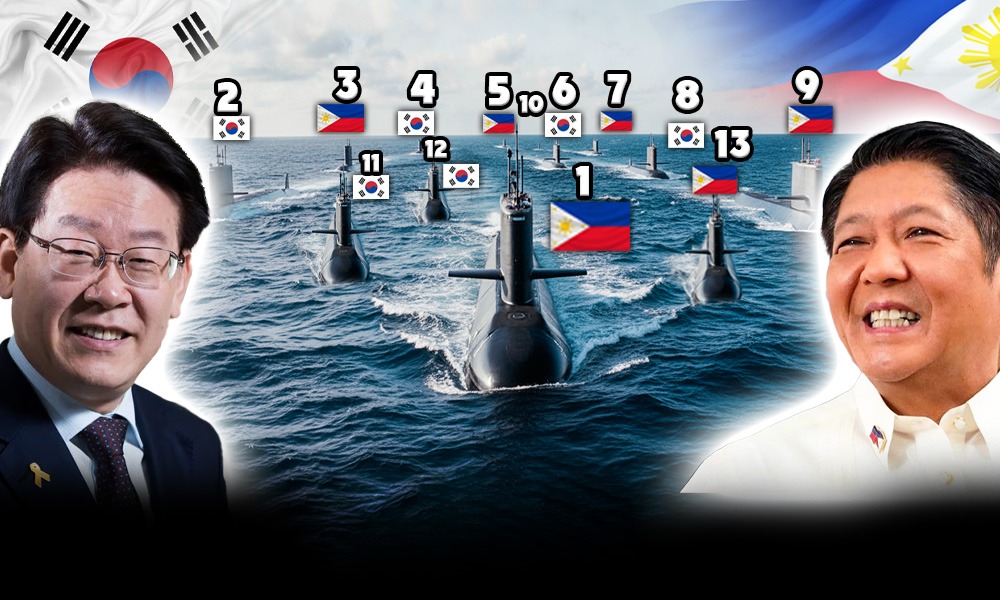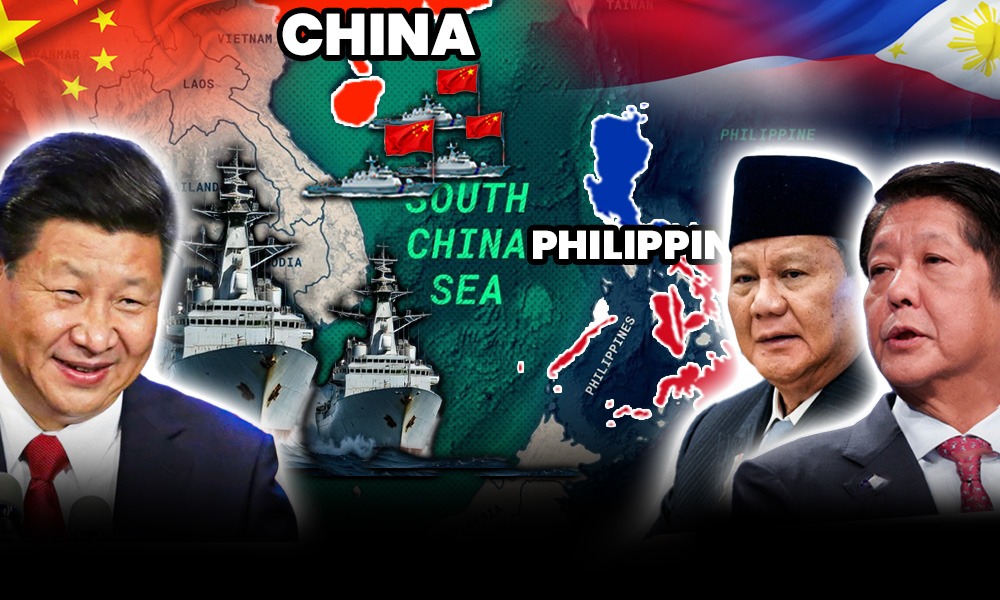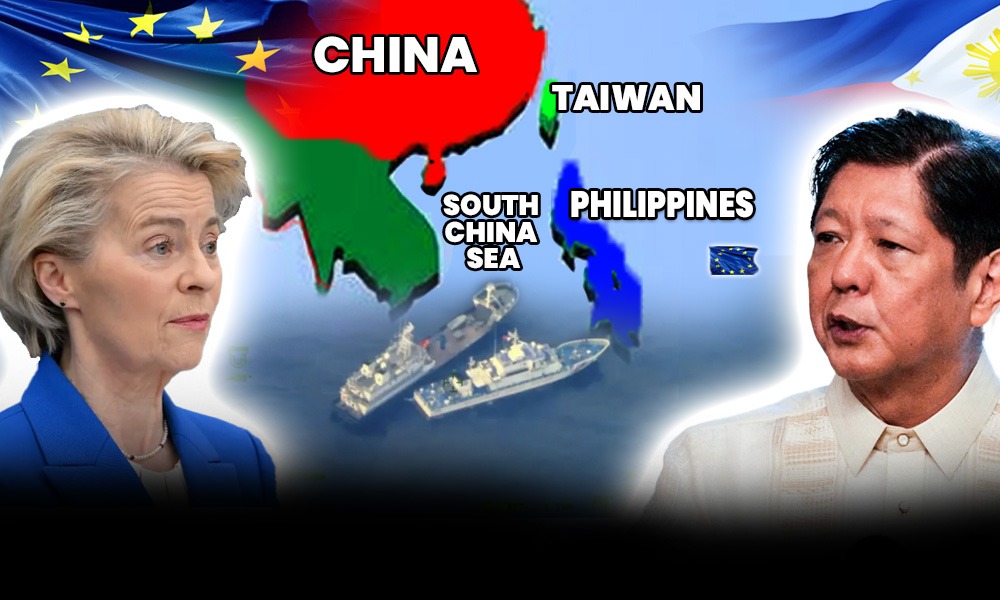Philippines Negotiates Submarine Deal With South Korea’s Hanwha
The Philippines is entering a transformative phase in its national defense strategy as it negotiates its first-ever submarine acquisition, a historic move decades in the making. For an archipelagic nation with over 7,600 islands and a 2.2 million square kilometer maritime domain, the absence of a submarine fleet has long been considered a critical strategic vulnerability. This gap has left the country with limited capacity to monitor, deter, or respond to incursions in its vast Exclusive Economic Zone (EEZ), particularly in the contested waters of the West Philippine Sea (WPS). The new submarine initiative aims to close that gap and strengthen maritime deterrence amid escalating regional tensions.
The push for submarines is a central feature of the Revised Armed Forces of the Philippines (AFP) Modernization Program, Horizon 3 (2023–2038), officially approved in January 2024. This phase focuses on advanced defense systems, including multi-domain capabilities such as undersea warfare, cyber defense, and long-range strike platforms. The strategic urgency of this acquisition reflects the growing pressure on the Philippines to safeguard its territorial integrity against China’s increasingly aggressive activities including blockades, ramming incidents, and harassment of Philippine ships in its own EEZ.
At the forefront of this historic initiative is Hanwha Ocean, a South Korean shipbuilding giant and a leading contender to supply the Philippines’ first submarine fleet. In early November 2025, during the APEC Summit in Busan, President Ferdinand Marcos Jr. held high-level discussions with Hanwha executives, showing the importance of the deal. Hanwha’s proposal reportedly includes a “turnkey package” not only for the delivery of submarines themselves but also the establishment of a comprehensive undersea warfare ecosystem. This encompasses crew training, logistics and maintenance facilities, submarine base construction, and transfer of technology to ensure long-term self-sufficiency.
This marks more than just a defense purchase, it’s the birth of the Philippines’ submarine era. The negotiation represents a decisive step toward transforming the country’s navy from a surface-only force into a modern, multi-domain maritime power, capable of both defending national sovereignty and contributing to the stability of the broader Indo-Pacific region.
Latest Facts and Figures on the Acquisition Program
The Philippines’ long-anticipated submarine program has officially entered its most advanced stage yet, a landmark defense effort designed to transform the country’s maritime posture. According to senior defense officials, the program carries an estimated budget of ₱80 billion to ₱110 billion (approximately US$1.3 billion to $1.9 billion) and aims to procure at least two modern diesel-electric submarines. This acquisition represents the centerpiece of the AFP Modernization Program’s Horizon 3 phase, a strategic blueprint that prioritizes undersea warfare as essential to achieving credible deterrence in the West Philippine Sea.
Armed Forces of the Philippines (AFP) Chief of Staff General Romeo Brawner Jr. has described the initiative as both an aspiration and a necessity. “It’s a dream for us to get at least two submarines, we are an archipelago, so we need this kind of capability because it’s really difficult to defend the entire archipelago without submarines,” he said in an interview earlier this year. His statement shows the operational importance of stealthy undersea capabilities, platforms that can gather intelligence, track hostile fleets, and provide deterrence without being easily detected. For a country facing repeated incursions in its exclusive economic zone, the addition of submarines would fundamentally change how the AFP manages surveillance and defense operations across its vast maritime space.
Currently, several major international shipbuilders are competing for the contract, with each offering distinct technologies, financing models, and logistical advantages. Hanwha Ocean (South Korea) has emerged as a frontrunner, proposing the KSS-III PN, a customized version of its highly advanced KSS-III class submarine. This platform features air-independent propulsion (AIP) technology, long-range endurance, and modern combat systems, making it a suitable choice for extended operations across the South China Sea. Hanwha’s bid also includes a comprehensive turnkey package, covering training, maintenance infrastructure, and technology transfer to enable local sustainment of the fleet.
However, Hanwha faces tough competition from other global defense leaders. Naval Group (France) has offered its Scorpène-class submarines, renowned for their operational success with navies such as those of India, Malaysia, and Brazil. These vessels are known for their reliability, agility, and ease of maintenance, qualities that could appeal to a country acquiring submarines for the first time. Meanwhile, Navantia (Spain) has entered the competition with its S-80 Plus (S-80PN) submarine, notable for its new air-independent propulsion system and extended operational endurance. Additionally, Fincantieri (Italy) and Thyssenkrupp Marine Systems (TKMS, Germany) have jointly proposed the U212 Near Future Submarine (NFS), one of Europe’s most modern platforms, which integrates advanced stealth features and long-endurance underwater capabilities.
Each of these bids represents not only a different technological pathway but also a distinct strategic alignment. Choosing between European and South Korean suppliers will shape Manila’s long-term defense partnerships and influence the degree of technology transfer and industrial cooperation available to the Philippines. The submarine acquisition program is both a practical defense project and a strategic crossroads. It’s not simply about acquiring hardware; it’s about defining how the Philippines intends to project power, secure its maritime borders, and engage with its defense partners in an increasingly contested Indo-Pacific environment.
Luzon Strait: How the U.S. and Philippines Plan to Deter China’s Navy
Hanwha Ocean’s Proposal: Technology and Package Details
Hanwha Ocean’s proposal to the Philippines represents a comprehensive and forward-looking plan, not merely a sale of submarines, but the establishment of a complete undersea warfare ecosystem that would permanently elevate the country’s naval capabilities. At the center of this offer is the KSS-III PN, a customized variant of South Korea’s Dosan Ahn Changho-class (Batch II) submarines, regarded among the most advanced conventional submarines in the world. Designed specifically for the Philippine Navy, this platform integrates cutting-edge sonar, navigation, and combat systems that allow it to perform intelligence, surveillance, and reconnaissance (ISR) missions, as well as anti-surface and anti-submarine warfare, all while remaining undetected in contested waters like the West Philippine Sea.
One of the submarine’s defining features is its Lithium-Ion Battery propulsion system, a technological upgrade that places it ahead of traditional diesel-electric designs. This innovation enables the submarine to stay submerged for extended periods, operate more quietly, and recharge faster than those using lead-acid batteries or older Air-Independent Propulsion (AIP) systems. The result is superior stealth and endurance, two qualities essential for effective deterrence and sustained patrols in vast maritime territories. With a submerged displacement of approximately 3,500 to 4,000 tons, the KSS-III PN belongs to the largest and most capable category of non-nuclear submarines, offering both endurance and combat readiness suited for the Philippines’ strategic needs.
Beyond the submarine itself, Hanwha Ocean’s bid is structured as a turnkey defense partnership. The proposal includes assistance in building a dedicated submarine base and a Maintenance, Repair, and Overhaul (MRO) facility, ensuring that the Philippines can independently service and sustain its new fleet. The company also pledged comprehensive training programs for Filipino naval personnel, using advanced simulators and real-world operational instruction to develop a new generation of local submariners and technical experts. Moreover, Hanwha’s approach aligns with the government’s Self-Reliant Defense Posture (SRDP) program by committing to technology transfer and collaboration with local industries, allowing the Philippines to build indigenous capacity in undersea warfare support systems and logistics.
Hanwha’s proposal also draws strength from the broader Philippines–South Korea defense relationship, which has steadily expanded over the past decade. South Korea previously supplied the FA-50 light combat aircraft, now the backbone of the Philippine Air Force as well as the Jose Rizal-class frigates, key surface assets in the Philippine Navy. These successful projects have built mutual confidence, interoperability, and a foundation of trust between the two countries’ defense establishments.
Hanwha Ocean’s proposal positions South Korea not just as a supplier but as a strategic partner in the Philippines’ maritime transformation. By combining advanced submarine technology, infrastructure development, and human capital training, the KSS-III PN program could usher in a new era for the Philippine Navy, one where the country transitions from a surface-only force to a credible undersea power capable of protecting its sovereignty and maintaining stability across the Indo-Pacific.
Hegseth’s Daring Strategy to COUNTER China in Southeast Asia
Strategic Implications and Analysis
The Philippines’ move to negotiate a submarine deal with South Korea’s Hanwha Ocean carries far-reaching strategic implications for its defense posture, regional security role, and geopolitical partnerships. This initiative is not merely about acquiring a new platform, it signifies a major evolution in how the Philippines intends to defend its archipelagic territory, strengthen deterrence, and balance growing Chinese assertiveness in the West Philippine Sea (WPS).
At the core of this transformation lies the deterrence and maritime security dimension. Submarines are among the most potent instruments of defense for an archipelagic nation. Their ability to operate silently and remain undetected makes them uniquely suited for persistent surveillance, intelligence gathering, and deterrence operations. The Philippines, with a maritime jurisdiction spanning more than 2.2 million square kilometers, faces immense challenges in monitoring its waters. By deploying submarines, the country can fill this critical gap, enabling it to track foreign incursions, shadow hostile vessels, and maintain a continuous presence in areas like the WPS without direct confrontation. These undersea assets will be crucial for enforcing the Comprehensive Archipelagic Defense Concept (CADC), the AFP’s framework for safeguarding all territories and maritime zones under Philippine sovereignty. Submarines, therefore, represent not just a new military capability but the cornerstone of a self-reliant, multi-domain defense strategy that integrates surface, air, and undersea elements.
From a geopolitical standpoint, this potential agreement shows a deepening of the Manila–Seoul defense alliance, positioning South Korea as one of the Philippines’ most trusted strategic partners. Seoul’s Hanwha Ocean is not merely a supplier, it symbolizes South Korea’s role as a maritime power and defense innovator that shares the Philippines’ commitment to regional peace and stability. By anchoring its defense modernization to a partner like South Korea, the Philippines is diversifying its security dependencies beyond its traditional ally, the United States, while strengthening the Indo-Pacific network of like-minded democracies. As noted by the Philippine News Agency (PNA), the move is seen as “vital to strengthening the country’s defense posture amid escalating maritime tensions.” This partnership also situates the Philippines more firmly within the region’s evolving security architecture, complementing its ties with the U.S., Japan, and Australia under frameworks such as AUKUS and the Quad, while giving it new strategic depth through bilateral cooperation with a regional industrial power.
U.S. Missiles in Philippines Can REACH China Faster Than You Think
However, the decision on which submarine to accept remains highly competitive and multifaceted. The final choice will depend on a mix of strategic, financial, and industrial considerations. Competing bidders, France’s Naval Group (Scorpène-class), Germany and Italy’s TKMS/Fincantieri (U212 NFS), and Spain’s Navantia (S-80PN), are offering technologically advanced designs, each emphasizing different strengths. Yet the Philippine Navy’s priorities extend beyond just acquiring hardware; they center on technology transfer, long-term affordability, and domestic capability building. Hanwha Ocean’s proposal distinguishes itself in this regard, offering not just submarines but a comprehensive package that includes the construction of a submarine base, establishment of a Maintenance, Repair, and Overhaul (MRO) facility, and advanced training programs for Filipino sailors. Moreover, Hanwha’s readiness to subsidize or co-finance portions of the infrastructure and training dramatically reduces the financial barriers that have long delayed the Philippines’ submarine ambitions.
In strategic terms, this approach aligns with the Philippines’ Self-Reliant Defense Posture (SRDP), an initiative to foster local defense production and reduce foreign dependency. By integrating South Korean expertise with Philippine infrastructure and manpower, the partnership could mark a turning point in the nation’s defense industrialization. It would allow the Philippines not only to operate submarines but eventually to sustain, upgrade, and innovate its own undersea systems.
The submarine acquisition is a symbol of strategic maturity. It signals that the Philippines is no longer content with reactive defense policies and is instead building a credible deterrent force capable of shaping outcomes in its own maritime domain. Should the Hanwha deal proceed, it will redefine the country’s defense landscape, from a limited coastal force to a modern, multi-dimensional navy, while solidifying South Korea’s position as a pivotal partner in maintaining a stable, rules-based Indo-Pacific order.
Philippines Expands Patrol Zone in West Philippine Sea | China Shocked!
Conclusion: Looking Ahead
The planned acquisition of the Philippines’ first submarine fleet stands as a historic milestone in the evolution of the nation’s defense capabilities. For decades, the Philippine Navy has operated as a surface-only force, relying on patrol ships, aircraft, and allied support to monitor and secure its vast maritime domain. The introduction of a submarine capability will change that dynamic entirely, transforming the Philippines into a multi-domain deterrent power capable of defending its sovereignty both above and beneath the waves. This leap will not only enhance the country’s ability to safeguard its territorial waters and Exclusive Economic Zone but also symbolize its growing resolve to take an active role in ensuring stability and security across the Indo-Pacific region.
The recent meeting between President Ferdinand Marcos Jr. and Hanwha Ocean executives marks the most advanced phase of the Philippines’ submarine acquisition effort to date, moving the plan from aspiration to actionable strategy. With the Re-Horizon 3 modernization program serving as its foundation, the decision on which submarine platform to adopt is expected to come soon. Once finalized, the deal will signify more than just a defense purchase, it will represent a strategic transformation that strengthens alliances, builds local capacity, and cements the Philippines’ place among the region’s modern maritime powers. Looking ahead, the submarine project is poised to become a cornerstone of national defense and regional deterrence, ensuring that the country can protect its seas with both confidence and credibility in the years to come.



